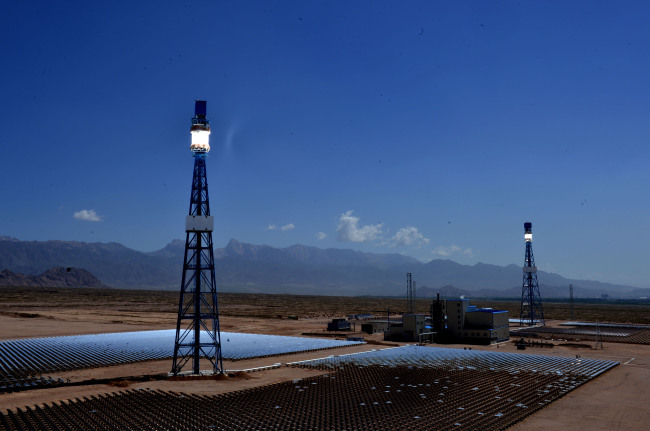HONG KONG (Reuters) ― Three quarters of China’s solar-grade polysilicon producers face closure as Beijing looks to overhaul a bloated and inefficient industry, resulting in fewer but better companies to compete against Germany’s Wacker Chemie AG and South Korea’s OCI Co Ltd.
The polysilicon sector, which has around 40 companies employing 30,000 people and has received investment of 100 billion yuan ($16 billion), suffers from low quality and chronic over-capacity as local governments poured in money to feed a fast-growing solar panel industry, for which polysilicon is a key feedstock.

A 50-megawatt solar thermal power plant in Delingha of Haixi Mongolian-Tibetan Autonomous Prefecture, northwest China’s Qinghai province. (Xinhua-Yonhap News)
Demand for solar panels has eased since the global financial crisis, forcing governments worldwide to slash solar power subsidies, and leaving China sitting on idle capacity and mounting losses. To help prop up the solar industry, Beijing plans to more than quadruple solar power generating capacity to 35 gigawatts (GW) by 2015 to use up some of the huge domestic panel glut. It has also said it will accelerate technological upgrades in polysilicon to weed out inefficient producers and “nurture a batch of internationally competitive producers.”
People in the polysilicon industry say the moves will halve China’s production capacity to 100,000 metric tons (110,231 tons) a year, leaving around 10 relatively strong firms with better technology and cost efficiency.
“Most producers will be eliminated rather than acquired. This may sound cruel, but is the reality as they are technologically uncompetitive,” Lu Jinbiao, a senior official at China’s top polysilicon producer GCL-Poly Energy, told Reuters.
The challenges mirror those faced by much of China’s manufacturing sector, from cement and steel to shipbuilding ― local governments chasing jobs and economic growth over-invested in often high-cost, low-tech capacity in the mid-2000s when demand for solar panels was booming. That boom is now over.
“Large amounts of ineffective, high-cost production capacity will exit the market,” said Ma Haitian, deputy secretary general of the Silicon Industry of China Nonferrous Metals Industry Association, a Beijing-based industry lobby.
As smaller polysilicon producers, with average annual capacity of a few thousand metric tons, are pushed out, the likely winners will be larger producers such as GCL Poly, TBEA Co Ltd, China Silicon Corp and Daqo New Energy Corp. The shake-out is already underway as polysilicon prices have plunged to below $20 per kg from a 2008 peak of almost $400, forcing some producers in the northwestern province of Ningxia and eastern China’s Zhejiang province to file for bankruptcy.
Their plight is made worse by cheaper, and better quality, imports from producers such as MEMC Pasadena Inc and Michigan-based Hemlock Semiconductor Group ― a venture of Dow Corning, Shin-Etsu Handotai and Mitsubishi Materials Corp ― and Norway’s Renewable Energy.
Of the 69,000 metric tons of solar-grade polysilicon China consumed in January-June, 41,000 metric tons were imported, according to industry data. China’s solar panel makers prefer imported polysilicon, which has a higher purity that helps in energy conversion, company executives say.
Foreign polysilicon producers can break even at prices of around $20/kg, while break-even for Chinese firms with capacity of 10,000 metric tons or more is $20-$25, say industry specialists, who noted that most smaller Chinese producers had begun to lose money when prices slipped to $30-$40.
“Restructuring is a must. Most Chinese polysilicon enterprises will disappear and only about 10 will survive,” said Glenn Gu, senior solar analyst at consultant IHS in Shanghai.
In an apparent bid to protect its domestic industry, Beijing this month imposed preliminary anti-dumping duties on U.S. and South Korean polysilicon imports, (ID:nL4N0FV1QI) but has yet to decide whether to do the same for European suppliers like Wacker Chemie. Analysts said that idea could be dropped after China and the European Union struck a solar panel trade deal last weekend. (ID:nL6N0FX04U)
“Such a settlement could mark the start of another global photovoltaics (solar technology) upturn,” Wacker Chemie said in announcing better-than-expected quarterly earnings on Tuesday, [ID:nL6N0G00GD] adding polysilicon prices may have bottomed.
Many of China’s leading solar cell and module manufacturers - such as LDK Solar Co Ltd, Yingli Green Energy Holding Co Ltd, Suntech Power Holdings Co Ltd and JA Solar Holdings Co Ltd - are sitting on long-term take-or-pay contracts with foreign polysilicon producers, under which they import set amounts at fixed prices of around $40-$50/kg, people in the industry said.
By some estimates, 30 percent of the $2.1 billion worth of polysilicon that China imported last year came from those contracts. Those deals looked good before the financial crisis, and some Chinese panel makers - who regularly mix imported polysilicon with local materials to control costs - also invested in their own polysilicon production.
Much of that investment has since been written off.






![[KH Explains] Hyundai's full hybrid edge to pay off amid slow transition to pure EVs](http://res.heraldm.com/phpwas/restmb_idxmake.php?idx=645&simg=/content/image/2024/04/18/20240418050645_0.jpg&u=20240419100350)